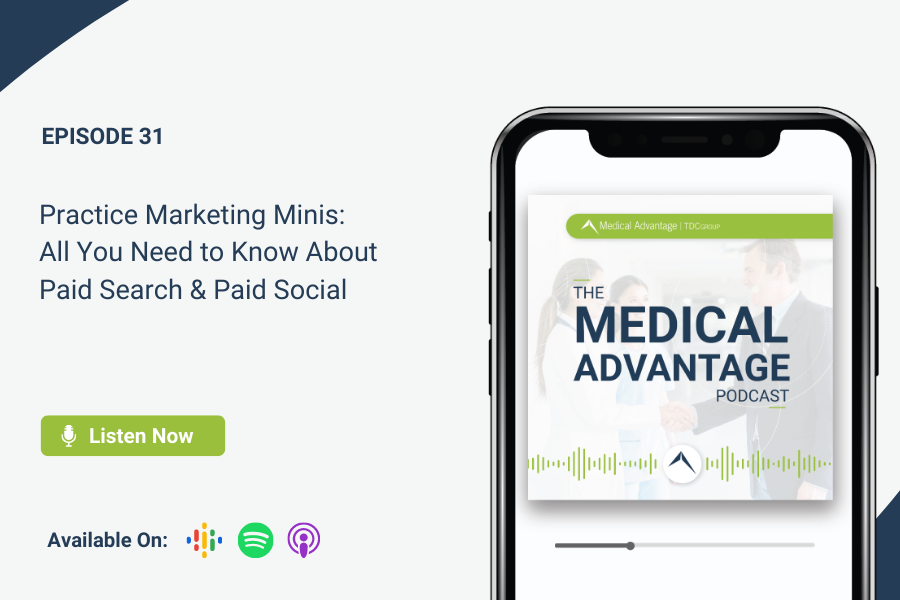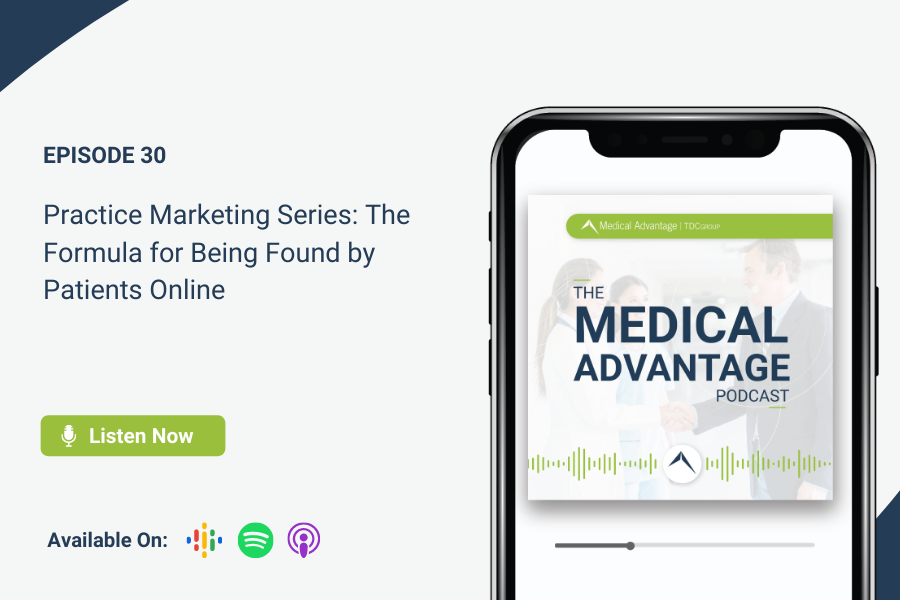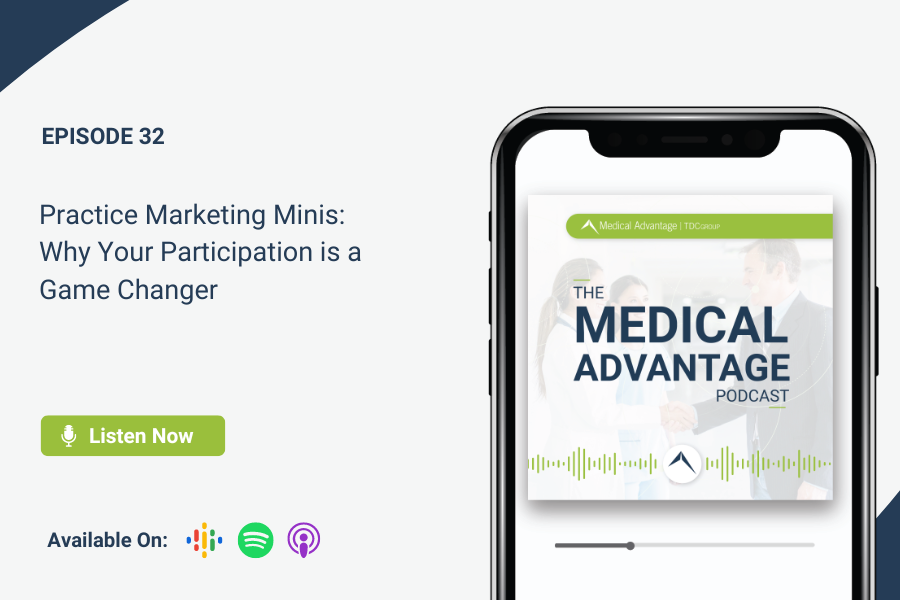Patients beginning their care journey online is a trend that shows no signs of stopping. From asking Google medical questions to seeing what providers are in the immediate vicinity, everything a patient needs to make moves toward getting the care they need is in the palm of their hand, or desktop browser. Even if a patient passes by your building every single day, to the modern healthcare consumer, your practice does not exist if it is not found online.
Organic search (when Google grants you search results placement based on website quality) can take many months or years to achieve. But the meantime, you CAN help patients find you with paid search or paid social. When planning out your medical practice marketing, it is wise to make room for paid ad spend where possible.
For practices needing to stay competitive, a digital medical practice marketing strategy is a must. Ensuring the health of your online presence is the best way to attract more patients these days. If you aren’t being found online like your competitors are, it is time to start asking why.
In this episode, we continue our conversation about healthcare marketing by going deeper into paid search and paid social as an online visibility driver. If you’re considering either one or the other, or both, you will definitely want to hear what we have to say so you can make an informed decision. We go into great detail about how both paid search and paid social works, and also compare these two forms of digital advertising.
We also share how one dental practice in Pennsylvania worked diligently to cope with a competitor who dominated search results for frequently used search term, and how paid search helped them through this challenge. Our marketing experts helped the paid search campaign be successful for this dentist to be found for a very specific (yet crucial) search term.
Hosted by Rebekah Duke, this episode of the Medical Advantage Podcast continues our practice marketing series based on our new eBook, hot off the presses and free to download: The Complete Medical Practice Digital Marketing Success Blueprint.
Thank you for joining us for this session of the Medical Advantage Podcast, where we take time each episode to discuss the ideas and technologies changing healthcare, and the best practices your organization can take to stay productive and profitable. Subscribe wherever you get your podcasts to ensure you never miss an episode. Download our free practice marketing eBook here!
Contact Our Team Today
Full Episode Transcript
Medical Advantage Podcast: Welcome to the Medical Advantage Podcast, where you can hear healthcare professionals, expert consultants, and industry thought leaders discuss the exciting new ideas and technologies that are changing the business of healthcare. Tune in to each episode as we hear from some of the most innovative minds in medicine about the future of healthcare and how your organization can stay profitable, efficient, and on top of industry best practices.
Rebekah Duke: Hello and welcome back to the Medical Advantage Podcast. For those of you new to our podcast and new to us, Medical Advantage is a healthcare services company offering solutions for medical practices, specialists, groups, and private equity. I’m Rebekah Duke, creative at Medical Advantage with another installment of our practice marketing series based on our recent eBook, complete Medical Practice Digital Marketing Success Blueprint available to download on our website. Today’s guest here to compare paid search versus paid social to reach your ideal patient is Mary Hall, Digital Marketing Master of Practice Marketing Growth.
Last episode, we cover what the core online visibility drivers are and how they power your digital marketing strategy to be found by patients online for your local market.
Welcome back, Mary.
Mary Hall: Thanks, Rebekah. Happy to be back.
Rebekah Duke: So could you give us a quick rundown of paid search versus paid social?
Mary Hall: Sure. So first when talking about paid advertising on both Google, Bing and Facebook and so forth the key element is the type of advertising that you’re doing and with Bing and Google it’s primarily what we call pay-per-click. So with pay-per-click advertising, you have the opportunity to have ads appear in the top three sections of a page or the bottom three sections of the page based on the bidding strategy that you have with paid ads.
On social, you can either pay for impressions, which I don’t really recommend. With impressions you’re going to pay based on the number of times your ad displays. As opposed to paying for it when somebody clicks on it. Or you can pay-per-click, with the pay-per-click advertising, you only pay when somebody clicks on the ad, not when it appears on that person’s newsfeed.
The ads for social media are different than ads for paid search on Google or Bing in that they’re very graphical. They’re larger and they run in the newsfeed based on criteria that you select. And Facebook gets a lot of information on their users, so you’re able to get very specific with who sees your ads. For example, if you were a weight loss clinic and you wanted to target women in a certain age group in a certain location that were specifically interested in weight loss, you can target that audience down to the point of whether or not they bought supplements for weight loss.
So you can get very specific and targeted with who sees the ads for your clinic so it’s very powerful advertising. The other really good advantage to social media advertising is that it tends to be less expensive than Google. Google pay-per-click ads can be expensive depending on how competitive they are and how much bidding is going on.
For those keywords with Facebook, we see that they’re a lot less expensive. And the same with Instagram as well, so you can get a lot more bang for your buck. But again, you’re not getting users searching, you’re showing the ads based on information you have about the user. So it’s a little less qualified, although it is pretty qualified in terms of who’s seeing the ads.
We do see good results with both types of campaign. Depending on the type of practice that you have, one may work better than the other. You know, with certain specialties, ads with graphics do better, especially plastic surgery, before and afters in dentistry can work very well on social media.
Whereas with Google and Bing, you’re gonna have more text-based ads with links. So that’s really the difference between the two advertising mediums. Both very powerful. Both allow you to generate new patients without too much risk really.
Rebekah Duke: Excellent. Thanks for walking us through paid ads, how they work in addition to campaign best practices. Very informative. So what would you say the number one advantage of paid search through Google is over social?
Mary Hall: That you’re getting very, very specifically searched on visitors, right. So I don’t know if that makes sense but the visitor on a Google search is going to their computer or their phone, and they are typing in a very specific search, whether it’s orthopedic surgeon near me, whether it’s urgent care center near me or whatever it is they happen to be looking for.
It’s a very targeted search, so when your ad appears, there’s a very good likelihood that the user clicking on it is looking for your service and is going to absolutely land on your website and make that phone call or fill out that form.
Advertising on social, it’s a little bit more fluid and you’re showing ads based on criteria, not necessarily because the user is looking for it. You’re showing it to them because the user has looked or purchased something related to what you do in the past or happens to be in the right demographic for your market. So it’s still qualified advertising.
But with pay-per-click on Google, you’re getting very definitive searches for your service.
Rebekah Duke: Yes, that makes perfect sense. And since most patient searches for provider starts with Google in the first place, then you definitely wanna have a presence on Google with your paid ads. And like you said, you can’t really secure those keyword searches without it.
Mary Hall: Correct. That’s right. And you’re dead right?
That most people’s searches begin with Google. You know, 99.9% of online searches are done using Google. So it’s really, really important that as a business you are making yourself visible on Google. You need to be where the patients are going, and patients are overwhelmingly using the internet.
And then I haven’t spoken to this in any of the recent podcasts, but I’ll bring it up now. Users are searching more for healthcare related information through Google and through the internet than ever before. And we are finding that patients not only search for health related topics, but they look for providers, they look up providers that they’ve been referred to.
So even if you’ve been referred to by insurance or by a another provider or a friend, that person is still gonna go to Google and look you up before they make that phone call. So having that presence is paramount to success and making sure that you are visible is absolutely key. The internet is here to stay and overwhelmingly the population uses online search to find everything, and healthcare is no exception.
Rebekah Duke: Yes. That certainly paints a picture of what it’s like with modern day healthcare consumers.
Mary Hall: Correct.
Rebekah Duke: So you said that paid social is cheaper. Is that the number one advantage of paid social?
Mary Hall: I would say yes, for sure you can. You really, I mean, we’re talking about cents per click. Dollars per, you know, low dollar per click. Where with Google, you know, depending on the keywords you could pay over $10 a click depending on the keyword sometimes.
So we work to mitigate that when we do the bidding but there’s sometimes where you just can’t get around it. So it’s definitely much more bang for the buck using social to advertise.
Rebekah Duke: Thank you for that confirmation. So how would you say that paid search helps a practice in a heavily competitive market for online visibility?
Mary Hall: It ensures you get to the top. Basically it ensures you get ahead of your competitor. It ensures that your ads are seen before anybody else’s.
And it’s really, really important for a lot of practices that they be front and center. Especially if they’re and not even necessarily in a highly competitive market, but even if there is just one or two practices that they really go up against, you know, making sure that you’re getting ahead of them. And paid search allows you to do that.
Rebekah Duke: Yes, it certainly is imperative in a competitive market to have that paid search presence. So would you say that paid social helps at all with competition?
Mary Hall: Not as much. Not as much. I mean, again, you’re getting very specific with who’s seeing those ads that there, there’s less competition in that space. I mean you could have some but Google is much more competitive.
Rebekah Duke: So I’ve heard about retargeting with digital marketing. Would you walk us through a situation where that would help with your campaign?
Mary Hall: Sure. So with retargeting, you get an opportunity if a user searches for something, they click on your ad, they come to your website and they leave without taking action.
You can retarget those customers by following them with display ads on other websites that they visit so it can be effective advertising. You have to be careful with how much you show them those ads because it can actually deter people as well. So there’s a fine balance between showing the ad and reminding them that you’re there and annoying the user with ads constantly.
So you know, there is a fine line for how to do that. But it can definitely be effective, especially if there was a user who was interested in your service but wasn’t quite ready to commit. And then they see the ad a little bit later, you know, somewhere else, and boom, they click and they come and they convert. So it can work very, very well if done correctly.
Rebekah Duke: Yes. There’s a delicate balance between annoying someone and reminding them that you are still available for service.
Mary Hall: Exactly. You know, ads that have followed us around forever, so.
Rebekah Duke: Oh, definitely it’s like, I heard you the first 10 times.
So you’ve been in the healthcare space for a long time now, and you’ve seen it all. Could you share a story of a practice that deployed both paid search and paid social for maximum visibility online?
Mary Hall: Sure. We have a practice, it’s actually a dental practice in Zelienople, Pennsylvania. And this particular client, very specifically had a competitor with the name Zelienople in their name and so they came up in search a lot ahead of this practice.
And it was very hard to get them to, they were second in the organic search to this practice, so we recommended doing pay-per-click advertising to get them above them in the organic, to get them at the very, very top. And it’s worked incredibly well.
They you know, spend money specifically on Google pay-per-click and that Google generates a ton of new business for them that they weren’t getting before and has put them ahead of their competition in the search. So it’s done, you know, the job for doing that.
They also engaged with social ads and have been able to use social media ads you know, to attract new patients as well. And they’ve been able to do that with a relatively low spend you know per month. And they’re spending I think on social, something like $500 per month on their marketing only on social media.
And, you know, they’re generating 50 or 60 new patient appointments from that money just through social. So very effective advertising and, and both things have worked well for them.
Rebekah Duke: Awesome. Well, that’s our time for today. Thank you so much, Mary, for being here and sharing your industry insights. And thank you listener for joining us today.
For more direction on practice marketing strategy, download our eBook at the eBook section at medicaladvantage.com. And should you have any questions, you can always reach us directly by email at info@medicaladvantage.com.
Join us for our next episode on Practice Marketing coming soon.
Medical Advantage Podcast: Thanks for joining us this week on the Medical Advantage Podcast where we discuss the ideas and technologies changing healthcare and what they mean to your organization. For more information, visit us at medicaladvantage.com and make sure to subscribe to the podcast on iTunes, Spotify, or wherever you get your podcast, so you never miss a show.








